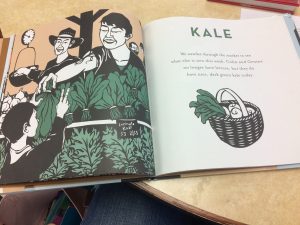To Market, To Market
Written and illustrated by Nikki McClure
Abrams Books for Young Readers, 2011
40 pages, Realistic Fiction
In To Market, To Market, Nikki McClure describes her experiences visiting a farmer’s market to buy fresh food to celebrate Market Day. Based on the Olympia Farmer’s Market that McClure frequents, this story follows a family’s shopping trip, including an in-depth look at the foods the family purchases and how it is made. The unnamed narrator is a young boy who describes the seven different items that his family buys and who they buy it from, and the next page includes information about how the food is grown or created, what it looks like, and when it is harvested or finished. Each section ends with a thank you to the people who planted, harvested, or cultivated the food, and the book ends with a celebration with all of the products from Market Day.
To Market, To Market primarily serves as a window for children who have never been to a farmer’s market or who do not know about the process of buying local foods from local people. For some children, this book may be a mirror, especially if their families are involved with food production, which may be an underrepresented group in modern children’s literature. While the characters are all drawn in black and white, there may be diversity in the book, especially with Yukie the napkin maker, but there is not explicit diversity in the pictures. With the farmer’s market, the narrator speaks about the vendors as his friends and neighbors, which shows an equality of power; the vendors are not superior nor inferior to the purchasers. The relationship between the vendors and the purchasers shows children the ways that buying food can be more than going to a supermarket; farmer’s markets allow people to connect with their neighbors and their products in a familiar and unique way.
The illustrations are done with a cut-paper technique and minimal colors; the people are all drawn in black and white, and the backgrounds are different colors with the specific product brightly colored. This design makes the goods stand out as the focus of the page, which is especially beneficial for some terms and images that children may be unfamiliar with, especially kale. The first page in the set of each product features the boy and his mother buying the food from the vendor, while the second page shows the process of making or harvesting the product itself. This technique focuses more on the efferent properties of children’s books, but the illustrations are thoroughly done and intriguing, which adds to the aesthetic of the book.
McClure adds an author’s note at the end to discuss her personal experience at the Olympia Farmer’s Market, including a thank-you to her own vendors and a call to find and support local farmer’s market, which can be a door for older readers who are interested in the idea of buying locally. She also includes details about her cut-paper technique.



